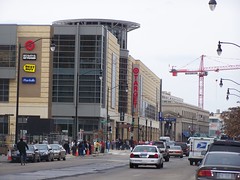Parking garages at Metro Stations
I sound like a hypocrite for stating that there are sometimes when you can support parking structure creation, given my general blog persona, but this has to do with recognizing the reality of consumer behavior. The point isn't to encourage driving, but to accommodate driving when necessary.
The parking garage in the old Sears building at Tenleytown, now the building is occupied by a hardware store, Best Buy, and a Container Store, is not used to capacity, because it is at a subway station, and I think Best Buy does delivery too. This has been known since 2004 at least. Richard Lake, principal of the company that developed the site, Roadside Development, has been upfront about this fact all along. The fact that urban shopping sites don't require as much parking as suburban sites is still taking time to sink in...
So I have been upset for a couple years about the fact that the city provided a $42 million loan to DC USA to build a massive parking structure there, immediately next to the Columbia Heights Metro Station. This was spearheaded by the Ward 1 Councilmember Jim Graham, who sent this to community e-lists earlier today:
Dear Friends:
Shoppers are using Metro in record numbers to get to Target and other stores. The evidence shows that new commerce is thriving in Columbia Heights--and transit use is part of the key.
Before the Target opened, residents were concerned about how all the new shoppers would affect their neighborhood- -some feared widespread auto gridlock.
Lots of people are traveling to the store. The store's opening day had the second highest sales of all Target stores in the country. Thankfully, many of them are riding Metro or walking.
Metro riders at Columbia Heights have increased 24% during weekdays compared to the previous year. On weekends, the number is up to 39%. Surely some of this relates to the high cost of gasoline, and a general switch to public transportation.
But, the retail center has a 1,000 car garage. The garage still hasn't reached capacity. On average, only 250 cars are there. During peak hours, 350-400 cars are there. In fact, the second level has not been used to date.
Also, 25% of the new Target employees live right here in Ward One--80% overall live in DC. With fewer employees needing to drive in, parking is more available.

Now if we could get Councilmembers to recognize this fact, and stop shilling for developers, and focus resources on optimal mobility, which in the city is transit not automobility. And rather than fund massive parking structures, we need shared delivery services in commercial districts.
Labels: parking, transportation planning



0 Comments:
Post a Comment
<< Home